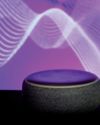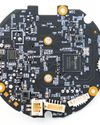
After purchasing an Echo smart speaker, Brian explores ways to control custom IoT gadgets by integrating Alexa voice recognition into an ESP32 board through an Arduino cloud service. In the first part of a two-part journey, he describes different methods, one through emulation and the second through custom integration. Both help him control his heat pump remotely.
I've built several custom IoT gadgets for my home which generally didn't require an outside cloud service host. While heavily promoted, I hadn't purchased any voice-enabled Amazon Echo devices, even though I have an Amazon Prime subscription.
However, when these Echo devices went on sale for about half-price, I ordered one of the better Echo smart speakers figuring it would have good enough sound quality for music listening, if nothing else. I was quite impressed with the Echo and a compatible smart plug and power receptacle that I also ordered at the time. In this article I'll refer to the Echo device and Alexa, the underlying cloud-based voice recognition engine, interchangeably.
Right from the start I was impressed at the ease of setup of the Echo device as well as how easy it was to pair them with the smart plugs/receptacle. I was also impressed with the Echo's ability to understand my voice. It seemed to understand virtually any of the phrases that I spoke. It didn't appear to make much difference how far I was away from the Echo, when issuing commands. It even seemed to ignore extraneous sounds, such as the TV being on, while I was speaking. I went through the Alexa voice "training" process initially, but Alexa was equally able to understand my wife, who has not done this "training" procedure.
Esta historia es de la edición November 2024 de Circuit Cellar.
Comience su prueba gratuita de Magzter GOLD de 7 días para acceder a miles de historias premium seleccionadas y a más de 9,000 revistas y periódicos.
Ya eres suscriptor ? Conectar
Esta historia es de la edición November 2024 de Circuit Cellar.
Comience su prueba gratuita de Magzter GOLD de 7 días para acceder a miles de historias premium seleccionadas y a más de 9,000 revistas y periódicos.
Ya eres suscriptor? Conectar

New TI MCUs Enable Edge AI and Industry-Leading Real-Time Control to Advance Efficiency, Safety, and Sustainability
Texas Instruments (TI) introduced two new series of real-time microcontrollers that deliver advancements to help engineers achieve more intelligent and secure processing in automotive and industrial applications.

Using Amazon Alexa to Control Custom IoT Gadgets
In part two of his article, Brian describes integrating custom IoT gadgets with Amazon Echo using emulation to receive spoken alarms. In part one, he used emulation and Arduino Cloud services as a middleman.

Holiday Hangover Hardware Hacking
Having too much cheer during the holidays? In this month's article, Colin offers a diversion from the jolly season by urging developers to retreat to the basement to brush up on hardware hacking skills. He shows how a low-cost Raspberry Pi Pico and a TP-Link Tapo C200 smart IP camera could become the next automated bird deterrent or a home automation server.

Datasheet: Microamps Per Megahertz Ultra-Low Power MCUs Minimize Current Consumption
How do chip makers differentiate if many ultra-low power MCUs on the market feature the same processor core? The peripherals and different power states offer various ways to manage current consumption down to microamps per megahertz.

Smart Home Lock Down Matter Provides Security Blanket
As more devices in the smart home connect to the Internet, they become increasingly vulnerable to outside attacks. Developers can now add the latest security measures to their Smart Home devices through Matter.

Basic Pulse Circuits
In part one of a three-part series, Wolfgang wrote how basic pulse circuits help digital circuits, such as embedded boards with ARM processors, deal with pulse trains or bursts of pulses from the outside. In Part 2, he dives into enabling flip-flops, timing parameters, and synchronization, design tasks needed to capture, detect, and filter pulses.

Building a Wi-Fi Router Watchdog
Dev created a watchdog for a Wi-Fi extender using a Raspberry Pi Pico. This monitors Wi-Fi connectivity for his smart home lighting system, which would require a reset twice a year due to rapid power interruptions.

Create Your Own PCBs with a CNC Milling Machine
Using KiCad, CopperCAM, and Candle Software

Performance Bottlenecks in Embedded Linux Solutions Analysis, Identification, and Mitigation
Good performance is a requirement for every technology, and system designers rely on operating systems to ensure fast and smooth transitions in critical applications. Fortunately, Pedro writes, the embedded Linux OS offers ways for finding, analyzing and mitigating performance bottlenecks so embedded systems can deliver the speed and efficiency that end users expect.

Renesas New RA8 Entry-Line MCU Groups Brings High Performance of Arm Cortex-M85 Processor to Cost-Sensitive Applications with Market-Leading CoreMark Performance
Renesas Electronics Corp., a premier supplier of advanced semiconductor solutions, introduced the RA8E1 and RA8E2 microcontroller (MCU) groups, extending the industry's most powerful series of MCUs.